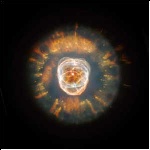Planetary Nebula Emission Line Catalog
 Image of NGC2392 courtesy NASA, A. Fruchter & the STScI ERO Team
Image of NGC2392 courtesy NASA, A. Fruchter & the STScI ERO Team

Welcome to the on-line version of the "Catalog of Relative Emission
Line Intensities Observed in Planetary Nebulae" (ELCAT for short).
This catalog contains all emission line fluxes that have been published
in the astrophysical literature through May 1995. This document
provides a way to browse and select for retrieval data from ELCAT.
Both general information about ELCAT,
and a summary of how the catalog is
formatted, are available.
ELCAT Components:
Related Software:
Software is available for making use of the data in ELCAT for scientific
research. The TABLES external package provides rich suite of
facilities for merging, sorting, selecting, manipulating, and printing all
or portions of ELCAT. The nebular package provides utilities for
deriving electron temperatures, densities, and ionic abundances from the
emission line fluxes.
- Retrieve TABLES
software
- Retrieve nebular
analysis software (requires TABLES)
This software is layered on IRAF, which can be
obtained from NOAO.

ELCAT is organized into 13 ASCII files (or 3 compressed ASCII files)
containing the published
intensities, and four ASCII files containing ancillary information. The
intensities are split into files of roughly 0.5 MB (or less) in size for
ease of retrieval, and are sorted on the object common name. A graphical
breakdown of the entries by discovery
catalog is available.
The intensities are in free-format ASCII tables. Each line of text is one
row of the table, and corresponds to one measurement of the flux in one or
more emission lines. Each row contains the following information:
- Nebula name
- Region code (may be a null string)
- Wavelength of the emission line (in Å)
- Ionic identification (e.g., [O III])
- Number of lines identified (N > 1 for a blend)
- Intensity
- Code for intensity scale (e.g. "H-beta" for I(H-beta) = 100)
- Boolean flag: interstellar extinction correction applied?
- Author code (see literature references)
- Host galaxy name (extra-Galactic PNs only)
The ancillary data is comprised of the objects list, which includes various
common name aliases and descriptive information; explanations of the
literature reference codes; explanations of the region codes, which may
include any special notations from or comments about the original paper;
and a list of discovery papers for planetary nebulae.

"A Catalog of Relative Emission Line Intensities Observed in Planetary
Nebulae" was produced by James B. Kaler and Louise Browning
(Univ. of Illinois), and Richard A. Shaw (Space Telescope
Science Institute). ELCAT contains nearly 70,000 entries on
1020 objects, and is roughly 5.5 MB in size, including the ancillary
information. An earlier version of this catalog (which also included
diffuse nebulae) was published in hardcopy form by Kaler (1976,
ApJS, 31, 1). A paper describing this updated version by
Kaler, Shaw, & Browning appeared in PASP, 109, 289 in
March 1997.
This project was funded by the NSF though various grants to the Univ. of
Illinois, and by the NASA Astrophysics Data Program through grants
NAG5-1400 to the Univ. of Illinois and NAG5-1432 to Space Telescope
Science Institute.

ELCAT Home Page ·
ELCAT Data ·
ELCAT Errata
Copyright © 1998, The Association of
Universities for Research in Astronomy, Inc. All rights reserved.
Dick Shaw (shaw@noao.edu)
Last update: 24 Jan 2002
 Image of NGC2392 courtesy NASA, A. Fruchter & the STScI ERO Team
Image of NGC2392 courtesy NASA, A. Fruchter & the STScI ERO Team Image of NGC2392 courtesy NASA, A. Fruchter & the STScI ERO Team
Image of NGC2392 courtesy NASA, A. Fruchter & the STScI ERO Team![]()
![]()
![]()
![]()